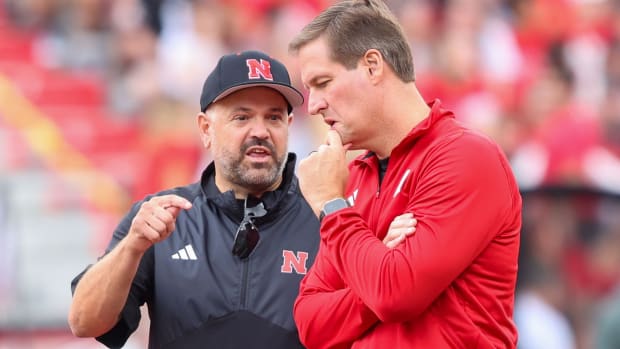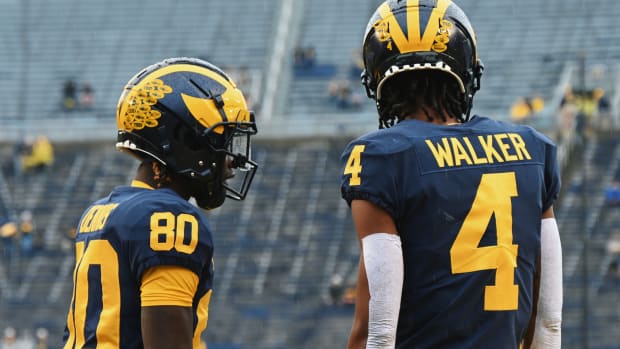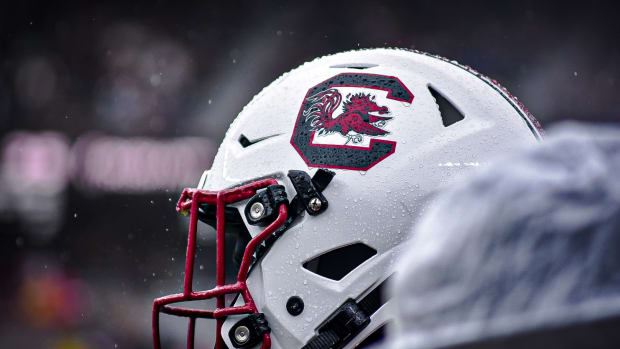SEC, Big Ten Would Benefit From Latest College Football Playoff 14-Team Expansion Model
After observing the power grab last week by the Big Ten and Southeastern conferences in regard to the College Football Playoff, a college administrator passed along the following quote from philosopher Antonio Gramsci:
“The old is dying and the new cannot be born; in this interregnum a great variety of morbid symptoms appear.”
This pithily sums up the purgatory college sports currently occupies, with amateurism limping off into the graveyard but a replacement model not yet brought into existence. The vacuum is filled with toxicity and turbulence, as everyone lunges for what they can get to stabilize their own fiefdom.
The CFP’s path to premature expansion reflects that, as did the conference realignment quakes of 2021, ’22 and ’23. Those with the power seek to add more power, disdainful of any damage to the entire college athletics landscape. Before even waiting to see how the 12-team playoff will work in 2024 and ’25, the power conferences are driving the bus on a proposed 14-team model for ’26 and beyond that would guarantee multiple automatic bids—three each for the Big Ten and SEC, two each for the Atlantic Coast Conference and Big 12. The Group of 5 conferences would be guaranteed one bid. The other three bids would be at-larges that are chosen by the selection committee.
Sports Illustrated confirmed Wednesday night what Yahoo Sports first reported about that format being “socialized” among college administrators. Everything is in the discussion phase, sources say, with nothing being formalized. But the so-called 3-3-2-2-1 model has some influential supporters.
That follows an attempted overreach proposed by Big Ten commissioner Tony Petitti for the two richest conferences to get four bids each. That was not well received. “There was pushback on four,” one college administrator familiar with the recent CFP discussions tells SI. “That was egregious. Four ain’t happening.”

The latest College Football Playoff expansion model for a 14-team field is a 3-3-2-2-1 model where the SEC and Big Ten would each receive three automatic bids into the field.
Kimberly P. Mitchell/USA TODAY Network
Perhaps indicative of typical negotiations, asking for too much set the stage for a compromise offer that in comparison would be palatable for the power leagues—though perhaps not anyone else. That’s where the so-called 3-3-2-2-1 model came from.
But make no mistake, this is still an attempt to bake in an advantage that those conferences shouldn’t need. Loaded with revenue and traditionally successful teams, the Big Ten and SEC should get at least three teams in a 14-team playoff every season—but that’s theory. In practice, they shouldn’t have those bids handed to them without merit. Same for the Big 12 and ACC potentially getting two bids.
In no other NCAA Division I sports are any conferences awarded more than one guaranteed bid before the season starts. Football, which already is played on the most uneven of playing fields, is looking at a model that would stack the deck even more in favor of the power conferences.
As one college administrator put it: “I don’t like a system that already has predetermined that one conference is better than another conference without having played any games.”
The formula for the 12-team playoff this season and next calls for five automatic bids and seven at-large selections. That at least gives more of a fighting chance—against admittedly long odds—to more of the 133 teams in the Football Bowl Subdivision. If more than one Group of 5 team has a special season, odds of getting into the field are better in a 5-plus-9 format than a 3-3-2-2-1 that offers just three at-large bids.
A power-conference administrator expressed reservations about further marginalizing the Group of 5 leagues: “They’re our feeder system. They feed us players, they feed us coaches, they feed us games, they feed us ADs.” But once the coaches and athletic directors move up to the power-conference level and experience all the advantages, they develop amnesia about where they came from.
In terms of each conference looking out for itself, a 3-3-2-2-1 format is a deal the Big 12 and ACC perhaps would be wise to embrace. With the Big Ten and SEC expanding after acquiring multiple recent national title contenders, those leagues could produce at least twice as many top-14 teams as anyone else.
Using future conference membership, the SEC had seven teams in the final College Football Playoff top 14 in 2023, while the Big Ten had five. The ACC had one (Florida State Seminoles) and the future Big 12 had one (Arizona Wildcats).
If future conference membership had been in play with a 3-3-2-2-1 formula in ’23, the CFP bids in a 14-team field would have gone as follows: automatics to the Michigan Wolverines, Washington Huskies and Ohio State Buckeyes from the Big Ten; Texas Longhorns, Alabama Crimson Tide and Georgia Bulldogs from the SEC; Florida State and No. 15 Louisville Cardinals from the ACC; Arizona and No. 20 Oklahoma State Cowboys from the Big 12; and No. 23 Liberty Flames from the Group of 5. The three at-large bids would have gone to No. 8 Oregon Ducks (Big Ten), No. 9 Missouri Tigers (SEC) and No. 10 Penn State Nittany Lions (Big Ten).
Without the protected second spot, both the Big 12 and ACC would have had just one team in that theoretical field while the SEC had six and the Big Ten had five, with Conference USA collecting the last auto bid.
But don’t look at this as the Big Ten and SEC doing the Big 12 and ACC a favor. They’re trying to push for as much as they can get, trying to operate a system that declares their leagues will always be the best and trying to pull everyone along under that working assumption.
“I still believe in the concept of the greater good, the health of the entire enterprise,” says another college administrator. “That’s not where we are going at the moment and perhaps has not been for a while. And while I believe that concept is the right way to operate, that approach in the long run is good even for the top dogs. A Darwinian approach is not going to enhance the enterprise.”
If anything, the top dogs seem scared to compete for at-large bids in a system where everyone starts out with the same number of guaranteed automatic bids. It’s just the latest morbid symptom to present itself as one form of college sports dies and the next one has not yet been breathed into existence.






